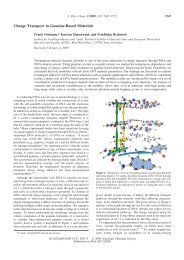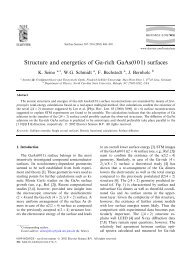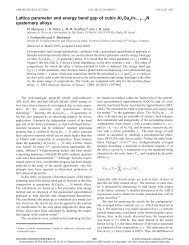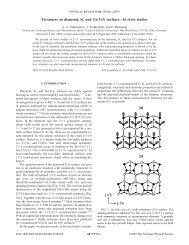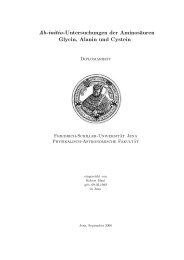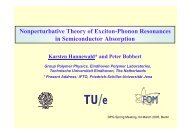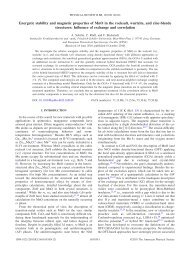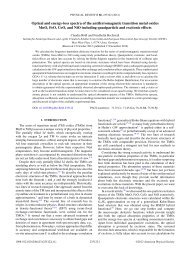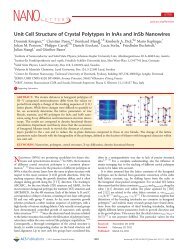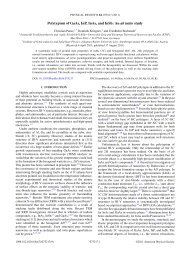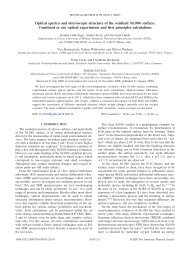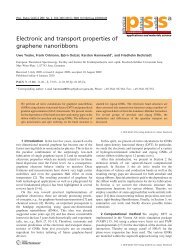Beyond the GW approximation - APS Link Manager - American ...
Beyond the GW approximation - APS Link Manager - American ...
Beyond the GW approximation - APS Link Manager - American ...
Create successful ePaper yourself
Turn your PDF publications into a flip-book with our unique Google optimized e-Paper software.
BEYOND THE <strong>GW</strong> APPROXIMATION: COMBINING ... PHYSICAL REVIEW B 85, 155131 (2012)<br />
10<br />
100<br />
exact and pp T matrix<br />
pp screened T matrix<br />
<strong>GW</strong><br />
(ε 0 +U)/t<br />
(ε 0 +3U/4)/t<br />
(ε 0 +U/2)/t<br />
50<br />
5<br />
ω a /t<br />
ε 0 /t<br />
0<br />
-50<br />
-5<br />
0<br />
2<br />
4<br />
U/t<br />
6<br />
8<br />
10<br />
2 3 4 5 6 7 8 9<br />
100<br />
Log (U/t)<br />
t . A(ω)<br />
FIG. 5. Two-site Hubbard model at 1/4 filling: Comparison between <strong>the</strong> exact spin-down renormalized addition energies ω a /t (solid lines)<br />
as a function of U/t (left panel) and log(U/t) (right panel) and <strong>the</strong> results obtained from <strong>GW</strong> (dashes) and particle-particle (solid lines, equal to<br />
<strong>the</strong> exact result) and (approximate) screened T matrix (triangles). In <strong>the</strong> atomic limit, <strong>the</strong> spectral function, i.e., <strong>the</strong> peak positions and weights,<br />
is illustrated on <strong>the</strong> right-hand side, on multiplying by t and taking <strong>the</strong> t → 0 limit.<br />
although it does not reproduce <strong>the</strong> exact result, it produces <strong>the</strong><br />
correct number of peaks in <strong>the</strong> spectral function, unlike <strong>the</strong><br />
<strong>GW</strong> <strong>approximation</strong>s that yields only one peak. Therefore, even<br />
in this approximate version <strong>the</strong> screened T matrix I contains<br />
<strong>the</strong> essential interaction processes. Note that <strong>the</strong> dynamically<br />
screened T matrix I reproduces exactly <strong>the</strong> atomic limit for<br />
<strong>the</strong> present problem.<br />
The screened T matrix II, instead, does not reproduce<br />
correctly <strong>the</strong> atomic limit. Indeed, with W = v c , <strong>the</strong> screened<br />
T matrix II reduces to <strong>the</strong> O 2 component only of <strong>the</strong> T matrix,<br />
and this is not sufficient to capture <strong>the</strong> interactions in <strong>the</strong> atomic<br />
limit. One finds <strong>the</strong> self-energy<br />
pp,↑<br />
ij<br />
(ω) = eh,↑<br />
ij<br />
(ω) = 0 (51)<br />
pp,↓<br />
ij<br />
(ω) = eh,↓<br />
ij<br />
(ω) = U 2 δ ij , (52)<br />
which is <strong>the</strong> same as <strong>the</strong> one obtained within <strong>GW</strong>.<br />
B. Hubbard molecule, 1/2 filling<br />
We now consider <strong>the</strong> case with two electrons in <strong>the</strong> ground<br />
state. Technical details are given in Appendix C (see also<br />
Ref. 70).<br />
1. T matrix<br />
In this case, nei<strong>the</strong>r <strong>the</strong> pp nor <strong>the</strong> eh T matrix reproduce<br />
<strong>the</strong> exact result, with <strong>the</strong> self-energy reading as<br />
pp,σ<br />
ij<br />
(ω) = U 2 δ ij + U 2 [<br />
t 1<br />
4 ¯h ω − t − ¯h + iη<br />
]<br />
+ (−1)(i−j)<br />
(53)<br />
ω + t + ¯h − iη<br />
with ¯h 2 = 4t 2 + 2tU, in <strong>the</strong> particle-particle T -matrix <strong>approximation</strong>,<br />
and<br />
eh,σ<br />
ij<br />
(ω) = U 2 δ ij + U 2 [<br />
t 1<br />
4 ¯h ′ ω − t − ¯h ′ + iη<br />
+<br />
(−1) (i−j)<br />
ω + t + ¯h ′ − iη<br />
]<br />
, (54)<br />
with ¯h ′2 = 4t 2 − 2tU, in <strong>the</strong> electron-hole T -matrix <strong>approximation</strong>.<br />
The pp T matrix performs ra<strong>the</strong>r well over a wide U/t<br />
range as one can see in Fig. 6, where <strong>the</strong> renormalized addition<br />
and removal energies ω/t are plotted versus U/t. In particular,<br />
<strong>the</strong> satellite energies (outer energies) are better described than<br />
in <strong>GW</strong>, in line with previous findings. 12,21,22 The energies<br />
calculated using <strong>the</strong> electron-hole T matrix, instead, show<br />
divergencies. In <strong>the</strong> U/t →∞ limit, all <strong>approximation</strong>s<br />
studied are ra<strong>the</strong>r poor.<br />
In <strong>the</strong> atomic limit, <strong>the</strong>re are no double occupancies,<br />
<strong>the</strong>refore, <strong>the</strong> two electrons, one with spin up and <strong>the</strong> o<strong>the</strong>r<br />
with spin down, are localized one on one site and <strong>the</strong> o<strong>the</strong>r on<br />
<strong>the</strong> o<strong>the</strong>r site with equal probability, i.e., <strong>the</strong> ground state is <strong>the</strong><br />
singlet | 0 〉= √ 1<br />
2<br />
(|↑↓〉 − |↓↑〉). The spectral function, thus,<br />
shows, for each spin, two peaks with <strong>the</strong> same spectral weight<br />
1/2, one for <strong>the</strong> removal of an electron (peak at ɛ 0 ) and one for<br />
<strong>the</strong> addition of a second electron (peak at ɛ 0 + U), as shown in<br />
Fig. 6. In Appendix C we show that, using <strong>the</strong> noninteracting<br />
Green’s function, <strong>GW</strong> fails also in <strong>the</strong> case of 1/2 filling,<br />
producing for each spin only one kind of peak at ɛ 0 + U/2 with<br />
spectral weight 1/2, both for electron removal and addition.<br />
This can again be understood considering that <strong>GW</strong> treats <strong>the</strong><br />
charge/spin density as a classical distribution, namely a half<br />
electron with half spin up and a half electron with half spin<br />
155131-9



